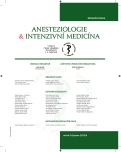Desflurane facilitates a successful wake-up test in scoliosis surgery in children. Case report
Authors:
Marešová Dagmar; Vymazal Tomáš
Authors‘ workplace:
KARIM, 2. LF UK, Fakultní nemocnice v Motole
Published in:
Anest. intenziv. Med., 24, 2013, č. 4, s. 237-239
Category:
Anaesthesiology - Case Report
Overview
The case report depicts scoliosis surgery and a wake-up test in a 14-year old girl with BMI 22.1 who was in care of a paediatric orthopaedic surgeon for idiopathic scoliosis. She wore a corset for four years but it was ineffective and scoliosis surgery became indicated. The girl was in care of an endocrinologist due to thyroideal hypofuction and a paediatric cardiologist due to a persistent systolic murmur and bifascicular blockade. Appropriate choice of short acting and easy to control drugs used for the general anaesthesia, desflurane included, contributed to smooth surgery and rapid, full wakefulness necessary for the wake-up test. Desflurane facilitates a reliable wake-up test in children undergoing scoliosis surgery and delivers safe and effective general anaesthesia.
Keywords:
scoliosis – wake-up test in children – desflurane
Sources
1. Palmer, G. M., Pirakalathanan, P., Skinner, A. V. A multi-centre multi-national survey of anaesthetists regarding the range of anaesthetic and surgical practices for paediatric scoliosis surgery. Anaesth. Intensive Care, 2010, 38, 6, p. 1077–1084.
2. Seol, T. K., Han, M. K., Lee, H. J., Cheong, M. A., Jun, J. H. Bispectral index and their relation with consciousness of the patients who receive desflurane or sevoflurane anesthesia during wake-up test for spinal surgery for correction. Korean J. Anesthesiol., 2012, 62, 1, p. 13–18.
3. Yamaguchi, K., Sumitomo, M. Anesthetic management with total intravenous anesthesia for intraoperative wake-up test in pediatric scoliosis surgery. Masui, 2010, 59, 12, p. 1522–1525.
4. Fung, N. Y., Hu, Y., Irwin, M. G., Chow, B. E., Yuen, M. Y. Comparison between sevoflurane/remifentanil and propofol/remifentanil anaesthesia in providing conditions for somatosensory evoked potential monitoring during scoliosis corrective surgery. Anaesth. Intensive Care, 2008, 36, 6, p. 779–785.
5. Adamus, M., Hrabalek, L., Wanek, T., Gabrhelik, T., Zapleta-lova, J. Intraoperative reversal of neuromuscular block with sugammadex or neostigmine during extreme lateral interbody fusion, a novel technique for spinal surgery. Journal of Anaesthesia, 2011, 25, 5, p. 716–720.
6. Cerny, V., Herold, I., Cvachovec, K., Sevcik, P., Adamus, M. Guidelines for managing neuromuscular block: not only Czech beer deserves a taste. Anesth. Analg., 2011, 112, 2, p. 482.
7. Berg, H., Roed, J. Residual neuromuscular blockis a risk factor for postoperative pulmonary complications. A prospective, randomised, and blinded study of postoperative pulmonary complications after atracurium, vecuronium and pancuronium. Acta Anaesthesiol Scand, 1997, 41, p. 1095–1103.
8. Bilotta, F. et al. and the PINOCCHIO Study Group Earlypostoperative cognitive recovery and gas exchange patternsafter balanced anesthesia with sevoflurane or desflurane in overweight and obese patients undergoing craniotomy: a prospective randomized trial. J. Neurosurg. Anesthesiol., 2009, 21, p. 207–213.
Labels
Anaesthesiology, Resuscitation and Inten Intensive Care MedicineArticle was published in
Anaesthesiology and Intensive Care Medicine

2013 Issue 4
Most read in this issue
- Development of the specialty of anaesthesiology and resuscitation at Kladno Hospital in the memoirs of Dr Vladimir Lemon, the first head of the department
- Immune homeostasis (deregulation) in sepsis and septic shock
- Anaesthesia for irreversible electroporation (IRE) prostatectomy: Reversal of neuromuscular blockade with sugammadex vs neostigmin. Retrospective study
- Desflurane facilitates a successful wake-up test in scoliosis surgery in children. Case report
